Introduction: The Quintessence of Florentine Grace
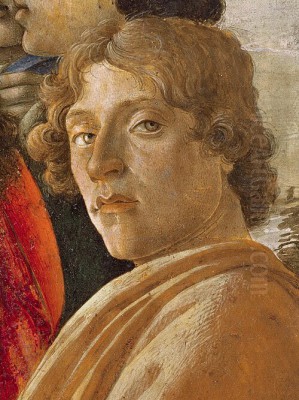
Sandro Botticelli, born Alessandro di Mariano di Vanni Filipepi around 1445 in the vibrant city of Florence, stands as one of the most celebrated painters of the Early Italian Renaissance. His name evokes images of ethereal beauty, flowing lines, and captivating mythological narratives. Working during a period of immense cultural and artistic flourishing, Botticelli developed a distinctive style characterized by its linear elegance, delicate coloration, and profound engagement with the humanist and religious currents of his time. Though his fame waned after his death, a resurgence of interest in the 19th century cemented his legacy, ensuring his place as a pivotal figure in the history of Western art. His masterpieces, particularly Primavera and The Birth of Venus, remain iconic symbols of the Florentine Renaissance.
Early Life and Artistic Formation
Alessandro Filipepi grew up in the Ognissanti district of Florence, a working-class neighborhood. His father was a tanner, a respectable but modest profession. The nickname "Botticelli," meaning "little barrel," likely originated with his elder brother Giovanni, who was apparently stout. Another brother, Antonio, was a goldsmith, and it is widely believed that Sandro received his initial artistic training in this meticulous craft. This early exposure to goldsmithing likely contributed to the precision, clarity, and emphasis on line that would become hallmarks of his painting style.
Recognizing his talent lay more in painting, Botticelli entered the workshop of Fra Filippo Lippi around the early 1460s. Lippi, a prominent Carmelite friar and painter, was known for his tender Madonnas, decorative richness, and expressive use of line. Under Lippi's tutelage in Prato, Botticelli absorbed these qualities, mastering the techniques of tempera painting and developing a sensitivity to graceful contours and delicate human forms. Lippi's influence is palpable in Botticelli's early depictions of the Madonna and Child, which echo his master's warmth and intimacy.
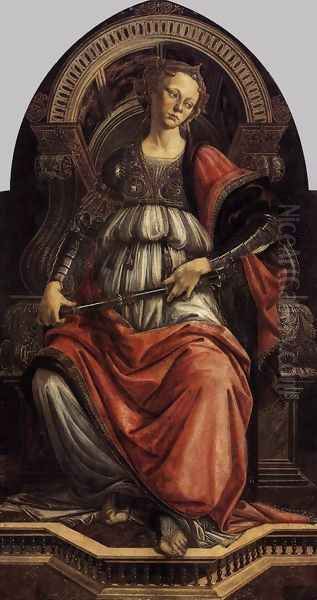
After Lippi left for Spoleto around 1467, Botticelli may have spent time in the workshop of Andrea del Verrocchio. Verrocchio's studio was a powerhouse of Florentine art, training not only Botticelli but also future giants like Leonardo da Vinci, Perugino, and Lorenzo di Credi. Exposure to Verrocchio's emphasis on anatomical accuracy and sculptural form likely broadened Botticelli's artistic vocabulary, even if his own style ultimately prioritized linear grace over strict anatomical realism. Influences from other Florentine masters, such as the powerful figural compositions of Masaccio and the dynamic linearity and anatomical exploration of Antonio and Piero del Pollaiuolo, also shaped his developing aesthetic.
Independence and Early Florentine Success
By 1470, Sandro Botticelli had established his own independent workshop in Florence, signaling his arrival as a recognized master. His reputation grew rapidly, attracting commissions from prominent Florentine families and institutions. An early documented work from this period is the allegorical figure of Fortitude (1470), painted for the Merchants' Court (Tribunale della Mercanzia) to complete a series of Virtues begun by Piero del Pollaiuolo. This commission demonstrated Botticelli's ability to work on a public scale and hold his own alongside established artists.
In 1472, Botticelli formally enrolled in the Compagnia di San Luca, the painters' guild of Florence, further solidifying his professional standing. His workshop became increasingly busy, producing devotional paintings, particularly Madonnas, often in the popular tondo (circular) format, as well as portraits and smaller narrative scenes. Filippino Lippi, the talented son of his former master Fra Filippo Lippi, joined Botticelli's workshop during this period, initially as an assistant and later developing into a significant artist in his own right, sometimes collaborating closely with Botticelli.
One of the most significant works cementing his early fame is the Adoration of the Magi (c. 1475), now housed in the Uffizi Gallery. Commissioned by Gaspare di Zanobi del Lama for his funerary chapel in Santa Maria Novella, this painting is remarkable not only for its complex composition and rich coloration but also for its inclusion of prominent members of the powerful Medici family portrayed as onlookers and even as the Magi themselves. This work clearly signaled Botticelli's burgeoning relationship with Florence's de facto ruling family.
The Medici Circle and Mythological Masterpieces
Botticelli's connection with the Medici family, particularly the circle around Lorenzo de' Medici ("the Magnificent"), proved crucial to his career and artistic direction. Lorenzo presided over a sophisticated court culture steeped in Neoplatonic philosophy and humanist learning, which sought to reconcile classical antiquity with Christian thought. Botticelli became one of the foremost visual interpreters of this complex intellectual environment, translating its ideals into paintings of extraordinary beauty and allegorical depth.
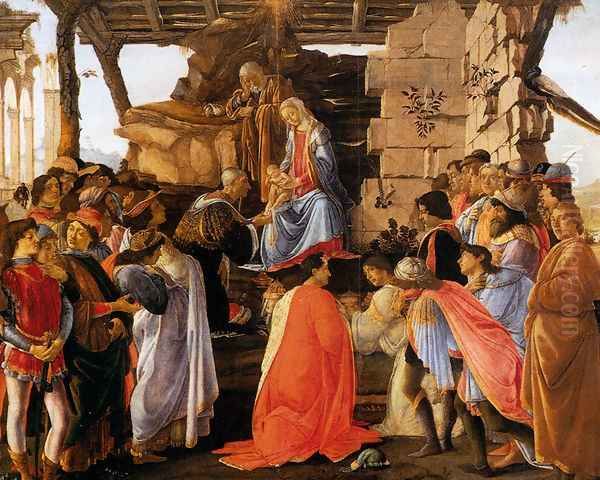
His most famous mythological paintings were likely commissioned by Lorenzo di Pierfrancesco de' Medici, a cousin of Lorenzo the Magnificent, for his private villa. The Primavera (Allegory of Spring), painted around 1477-1482, is a complex allegory featuring Venus at the center, presiding over a garden scene populated by figures like Mercury, the Three Graces, Flora, Chloris, and Zephyrus. The precise meaning remains debated, but it likely draws on classical texts and humanist poetry, possibly celebrating love, fertility, and the arrival of spring, perhaps commissioned for a wedding. The painting is a triumph of linear design, with figures seemingly dancing across the canvas, their forms defined by elegant, flowing outlines.
Equally iconic is The Birth of Venus, created around 1485. This work depicts the goddess of love arriving on shore, gently blown by the wind gods (Zephyrs) and greeted by an attendant nymph (Hora) ready to clothe her. Unlike the Primavera, its composition is more focused and monumental. Based on classical descriptions of paintings of Venus Anadyomene (Venus rising from the sea), it embodies the Neoplatonic idea of divine beauty arriving in the world. The figure of Venus, possibly inspired by Simonetta Vespucci, a celebrated beauty associated with the Medici circle who died young in 1476, became an enduring standard of idealized female form. Both Primavera and The Birth of Venus showcase Botticelli's unparalleled ability to blend sensuous beauty with intellectual depth.
Other significant mythological works from this period include Pallas and the Centaur (c. 1482), an allegory possibly representing wisdom taming instinct or Medici political prowess, and Venus and Mars (c. 1483), depicting the goddess of love watching over the sleeping god of war, perhaps symbolizing the power of love to conquer strife. These works further demonstrate Botticelli's engagement with classical themes and his mastery of elegant composition and refined execution, solidifying his reputation as the Medici's preferred painter for sophisticated, allegorical subjects.
The Call to Rome: The Sistine Chapel Frescoes
Botticelli's fame extended beyond Florence. In 1481, he was summoned to Rome by Pope Sixtus IV, along with other leading Florentine and Umbrian painters, including Domenico Ghirlandaio, Cosimo Rosselli, and Perugino (Pietro Vannucci), to decorate the newly built Sistine Chapel in the Vatican. This prestigious commission was part of a diplomatic effort by Lorenzo de' Medici to reconcile Florence with the papacy after the Pazzi Conspiracy.
Working alongside these esteemed contemporaries, Botticelli contributed significantly to the fresco cycle depicting parallel scenes from the lives of Moses and Christ along the chapel walls, below the ceiling later famously painted by Michelangelo. Botticelli was responsible for three main narrative panels: The Temptations of Christ, The Punishment of Korah, Dathan, and Abiram, and The Youth of Moses. He also painted several of the standing Pope figures in the niches above the narrative scenes.
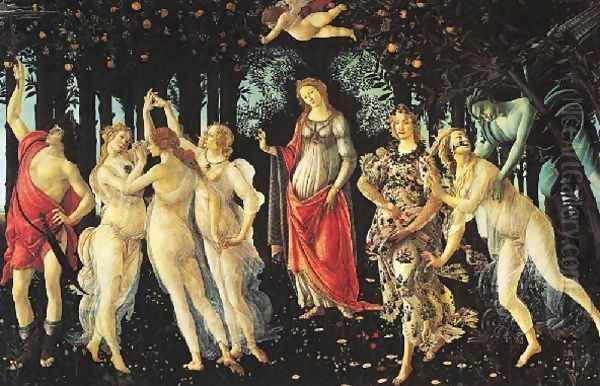
These frescoes reveal Botticelli's skill in handling complex multi-figure compositions and large-scale narrative. The Temptations of Christ cleverly integrates three distinct episodes into a single landscape. The Punishment of Korah is a dramatic depiction of divine retribution against those who challenged the authority of Moses and Aaron, a theme relevant to papal authority. The Youth of Moses portrays several key events from Moses's early life. While working within the collaborative framework of the chapel's overall program, Botticelli's distinctive linear style, expressive figures, and attention to detail remain evident. The Roman sojourn, though relatively brief (he returned to Florence in 1482), significantly enhanced his prestige.
Mature Religious Works and Portraiture
Upon his return to Florence, Botticelli was arguably at the height of his fame and productivity. He continued to receive major commissions for altarpieces and devotional works, alongside his ongoing production for private patrons. His workshop flourished, handling a significant volume of work. His religious paintings from the 1480s often display a heightened sense of drama and emotional depth compared to his earlier works, while retaining his characteristic elegance.
Notable altarpieces from this period include the Bardi Altarpiece (c. 1484-85), depicting the Madonna and Child enthroned between Saint John the Baptist and Saint John the Evangelist, commissioned for the Bardi family chapel in Santo Spirito. Another major work is the San Barnaba Altarpiece (c. 1487), featuring the Virgin and Child surrounded by saints and angels, notable for its intricate architectural setting and the expressive intensity of the figures. These large-scale works demonstrate his ability to orchestrate complex compositions with numerous figures while maintaining clarity and devotional focus.
Botticelli also continued to produce exquisite Madonna and Child paintings, many in the tondo format, such as the Madonna of the Magnificat (c. 1481) and the Madonna of the Pomegranate (c. 1487). These works are celebrated for their delicate beauty, intricate details, and tender portrayal of the relationship between mother and child, often imbued with a gentle melancholy. His skill in portraiture is evident in works like the striking profile portrait of Giuliano de' Medici (multiple versions exist, likely painted posthumously after Giuliano's assassination in 1478) and other portraits of young men and women from prominent Florentine families, capturing both likeness and inner character with sensitivity.
The Shadow of Savonarola and Late Style
The political and religious climate of Florence underwent a dramatic shift in the 1490s. The death of Lorenzo de' Medici in 1492 destabilized the political situation, leading to the expulsion of the Medici family in 1494 following the French invasion of Italy. In the ensuing power vacuum, the Dominican friar Girolamo Savonarola rose to prominence, establishing a theocratic republic in Florence. Savonarola preached fiery sermons denouncing worldly vanities, corruption, and the perceived paganism of Renaissance culture, calling for repentance and spiritual renewal.
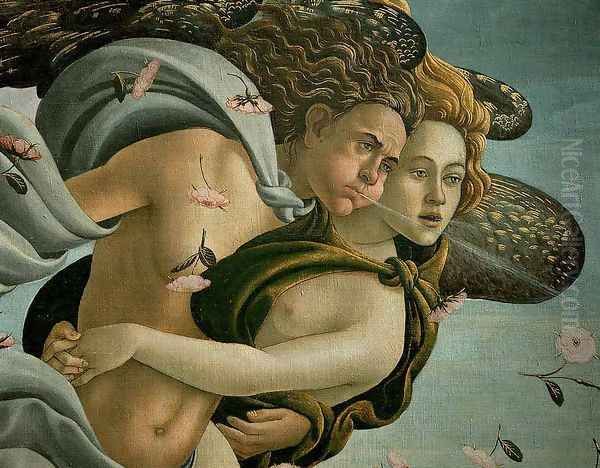
Savonarola's influence profoundly affected Florentine society and, it seems, Botticelli himself. The artist's brother, Simone, was a known follower of the friar. While the extent of Botticelli's personal adherence is debated, his art undeniably underwent a significant transformation during this period. His style moved away from the serene elegance and classical harmony of his earlier mythological and religious works towards a more intense, emotional, and overtly spiritual expression.
Giorgio Vasari, the 16th-century biographer of artists, claimed that Botticelli became a devoted follower of Savonarola (a "piagnone" or "weeper") and, caught up in the religious fervor, abandoned painting and even burned some of his earlier, secular works in the infamous "Bonfire of the Vanities" in 1497. While Vasari's account may be exaggerated – Botticelli certainly continued to paint – the shift in his artistic focus is undeniable. His later works often feature harsher lines, more agitated compositions, distorted proportions for expressive effect, and a darker, more somber palette.
Key works from this late period exemplify this change. The Calumny of Apelles (c. 1494-95), based on a classical description of a lost painting, is a complex allegory of injustice rendered with dramatic intensity and agitated figures. The Mystic Nativity (dated 1500), Botticelli's only signed and dated work, is imbued with apocalyptic symbolism and features a Greek inscription referencing the turmoil of the times and prophesying the end of tribulations. Its style is deliberately archaic, rejecting Renaissance naturalism in favor of medieval symbolic representation. Other late works, such as the Mystic Crucifixion (c. 1497-1500), various Pietàs, and depictions of Christ Crowned with Thorns, convey profound spiritual anguish and fervent piety through stark compositions and emotionally charged figures.
During this later period, Botticelli also undertook a major, though ultimately unfinished, project: illustrating Dante Alighieri's Divine Comedy. Commissioned likely by Lorenzo di Pierfrancesco de' Medici, this ambitious undertaking involved creating nearly one hundred detailed drawings on parchment, showcasing his mastery of line and narrative imagination. These drawings, lost for centuries and rediscovered in the 19th century, offer fascinating insight into Botticelli's late style and his deep engagement with Dante's epic poem.
Final Years and Declining Reputation
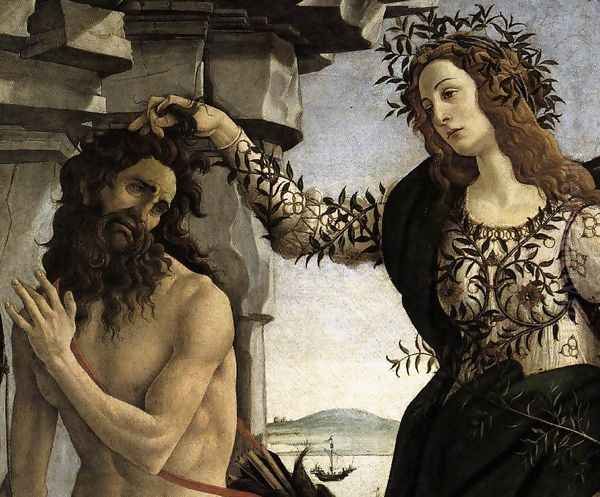
Savonarola's reign proved short-lived; he was excommunicated, arrested, and executed in 1498. Florence gradually returned to a more secular governance, eventually welcoming the Medici back. For Botticelli, however, the artistic landscape had changed irrevocably. The High Renaissance was dawning, spearheaded by artists like Leonardo da Vinci (who had returned to Florence), Michelangelo, and the young Raphael. Their emphasis on monumental forms, sfumato, anatomical perfection, and harmonious grandeur represented a different artistic ideal, making Botticelli's linear, somewhat archaic late style seem outmoded to many contemporaries.
Vasari paints a picture of Botticelli's final years as marked by poverty and inactivity, claiming he became infirm and unable to work. While he likely faced reduced commissions and financial difficulties compared to his peak years, evidence suggests he remained active to some extent. However, his influence waned significantly as the new titans of the High Renaissance captured the imagination of patrons and the public. Sandro Botticelli died in May 1510 and was buried in the cemetery of the Ognissanti church, the parish church of his family and the site of some of his earlier works.
Rediscovery and Enduring Legacy
After his death, Botticelli's reputation faded. For nearly three centuries, he was largely overlooked, overshadowed by the giants of the High Renaissance and subsequent Baroque masters. His rediscovery began in the early 19th century, fueled by a growing interest in the Early Italian Renaissance and a reaction against academic classicism. English collectors and critics played a key role in this revival.
The Pre-Raphaelite Brotherhood, particularly artists like Dante Gabriel Rossetti and Edward Burne-Jones, found inspiration in Botticelli's linear grace, poetic sensibility, and melancholic beauty. Critics like John Ruskin and Walter Pater praised his unique style and emotional depth, contributing to a reassessment of his artistic significance. By the late 19th century, Botticelli was once again recognized as a major figure, and works like Primavera and The Birth of Venus achieved the iconic status they hold today.
Sandro Botticelli's legacy rests on his unique contribution to the Florentine Renaissance. He masterfully blended Gothic grace with emerging Renaissance humanism, creating a style defined by lyrical line, delicate beauty, and intellectual sophistication. His mythological paintings remain unparalleled interpretations of classical themes filtered through the lens of Florentine Neoplatonism. His religious works evolved from serene devotion to intense spiritual expression, reflecting the turbulent times he lived through. Though his style fell out of favor for a time, its rediscovery affirmed its enduring appeal, securing Botticelli's place as one of the most distinctive and beloved painters of the Italian Renaissance, whose art continues to captivate viewers with its ethereal elegance and enigmatic charm.
Conclusion: A Master of Line and Spirit
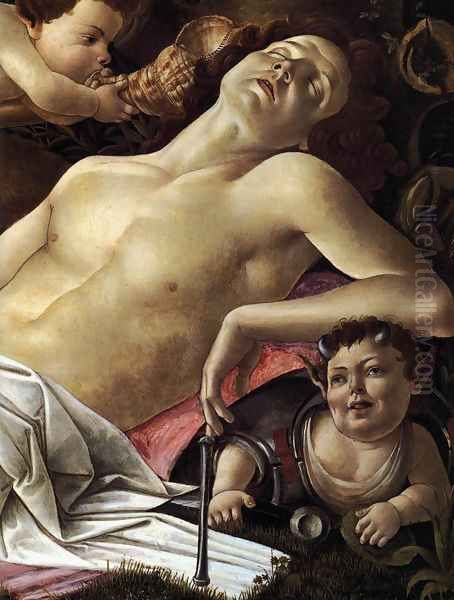
Sandro Botticelli navigated the complex artistic, intellectual, and political currents of late 15th-century Florence with extraordinary skill and sensitivity. From his early training under Fra Filippo Lippi to his mature masterpieces created under Medici patronage and his intense late works reflecting the influence of Savonarola, his artistic journey mirrors the evolution of the Florentine Renaissance itself. His unparalleled mastery of line, his creation of iconic images of mythological and religious subjects, and the unique blend of grace, melancholy, and spiritual depth in his work distinguish him among his contemporaries. Though briefly eclipsed by the High Renaissance, Botticelli's art possesses a timeless quality that ensured its rediscovery and secures his enduring position as a quintessential master of Florentine painting and a vital contributor to the tapestry of Western art history.